
A Guide to the Amphibians
and Reptiles of California

Living with Wild Amphibians and Reptiles

| (The phrase "Amphibians and Reptiles" is abbreviated here to "Herps.") Wild Herps and Humans Many people are fortunate to have native wild herps living on their property - frogs around artificial ponds; lizards in the backyard; gartersnakes that swim in the pool; gopher snakes under the porch; or salamanders that live under flower pots or even enter a swimming pool to breed. Others want to improve their property so they can encourage herps to take up residence. There are a number of resources available to help you learn how to attract wildlife to your yard. Most assume you want to attract birds, but some offer help with reptiles and amphibians. I have tried to assemble some basic information based on what I've read, and a little bit of my own experience with yard herps. I'm not a gardener or an expert on gardening for wildlife, but I have lived in and visited a number of areas of California where herps live on the property, in country, suburban, and urban settings, and I have done a little bit of reading about the subject. (There is no information here about caring for captive animals.) I have also assembled a list of links to information about the subject. This information is general and applies to a variety of climates and animals, not all necessary found in California. Let me know if you find any other good links or have information to share. If you are interested in dealing with venomous snakes on your property, check out some of the links here. Below the links on this page, I have compiled a list of herps that I have learned to be residents or regular visitors to urban or suburban properties around the state. The list and the locations are by no means meant to be complete, but they are a good place to start if you want to know what is living on your property. I will add more when I learn of them, so keep me posted. Look here for some information on a few of the many possible abandoned pets that might be found in California. Please be aware that it is unethical and illegal to release non-native reptiles or amphibians onto your property. Non-native species can kill or chase off native species, or bring in diseases against which the native species have no defense. (There are many, many examples of this, including the ecological devastation that happened when the Brown Tree Snake was introduced to the island of Guam, and the devastation of Hawaii's native bird population, caused by the introduction of many non-native species which brought in avian malaria against which the native birds were defenseless forcing them to live only at altitudes too high for the malaria mosquitoes to thrive.) |
|
What Kinds of Amphibians and Reptiles Might Live On Your Property |
|
| There are a number of factors which will determine the types of herps that might live in your yard or garden. Foremost, of course, will be where you live, and what herps naturally occur in the area, including established non-natives. The condition of the land surrounding your property is also important. If you live on a large tract of land in the country, then you are more likely to have a wider variety of herps. If you are close to undeveloped natural land, or land that has been allowed to remain somewhat natural that provides a corridor between your property and some natural habitat, then there is more opportunity for herps to move into your property. Herps are also capable of crossing roads and urbanized habitat, and sometimes they even find a niche there. The climate and how much shade and moisture and shelter are present are also important. If your yard is always dry and sunny, you probably won't have any amphibians. If it is always wet and shady, you will probably not have any reptiles. However, in some areas, you might see amphibians in the winter and reptiles in the summer. Southern California suburban yards often have lizards and maybe snakes, along with Garden Slender Salamanders that show up on the surface fall through spring, after rains. The presence of predators, including household pets, especially outdoor house cats, will also determine how many herps survive on your property. Here is a list of species that are fairly common in yards and gardens in California. |
|
Attracting Amphibians and Reptiles to Your Property and Encouraging Them to Stay |
|
It might seem like a good idea to put amphibians and reptiles in your garden to enjoy observing them or to control bugs gophers and other rodents, or other pests, but it is not legal in the state of California to collect or buy amphibians or reptiles to release onto your property for any reason, as stipulated in the California Department of Fish and Wildlife regulations excerpted below: California Department of Fish and Wildlife Restricted Species Laws and Regulations Manual 671, 2019: §2121. Escape or Release of Wild Animals No person having possession or control over any wild animal under this chapter shall intentionally free, or knowingly permit the escape, or release of such an animal, except in accordance with the regulations of the commission. Native Reptile Captive Propagation Laws and Regulations: §40. General Provisions Relating to Native Reptiles and Amphibians. (e) Reptiles or amphibians which have been in captivity, including wild-caught and captively-bred individuals or offspring, shall not be released into the wild without the written approval of the department.
Problems With Relocating Amphibians and Reptiles to Your Property
The fact that it against the law to do so should be enough to discourage you from relocating herps to your property, but if it doesn't, consider the well-being of the animals. It is much better to enhance your property to make it suitable for amphibians or reptiles than it is to try to add them. If amphibians or reptiles are not already living on your property, it probably does not provide the necessary conditions for them to survive there. If you try to relocate a wild or captive animal onto your property, it will probably die or move somewhere else. Many herps will immediately leave an unfamiliar area and try to return to their place of origin, which often results in them getting run over on a road or killed by predators as they expose themselves during the journey.
Enhancing Your Property for Wildlife
The best way to keep herps on your property is to encourage them to live there by providing them with conditions that they need to survive. Provide Shelter and Vegetation If you want to make your yard and garden into good habitat for wildlife, you will have to fight off the urge to keep things too neat and tidy. And you need to be careful when mowing and trimming plants and cleaning up so you don't kill any herps. You don't have to live in a jungle, but you should at least leave some leaves and other debris on the ground to help attract and sustain insects and to provide cover for herps, and you should provide other kinds of cover such as piles of rocks, branches, and other debris for them to shelter under, and to help them escape from dogs, cats, birds, racoons, or other predators. Along with shelter and hiding places, reptiles need open sunny areas where they can bask in the sun, but retreat into cover if they are frightened. Amphibians also appreciate sunny areas with cover to hide under, where they can enjoy the heat, but stay out of the direct sunlight. Walls with plants and shrubs next to them are perfect for lizards, as are piles of rocks or wood which get sunlight. Make sure there are no containers such as large empty flower pots that could trap herps if they fall into them. If there are potential container traps around, try to provide some sort of "ladder" for them to crawl up to get out. If you leave containers of water out for birds or other animals, you should also provide something that an animal that falls into the water can use to climb out, such as sticks that are angled out from the center of the container to the edge. Swimming pools also often trap herps. If possible, leave a net or something that sticks out of the water and contacts the edge of the pool. I've seen a commercial product that was designed to help frogs escape from swimming pools, and had a link to it here, but that link was broken. Perhaps you can find another one online. There may be herps on your property that you never see because they are secretive or nocturnal. If you want to learn what secretive herps might be on your property, you can lay out a few large rocks and small boards in areas where they were not too conspicuous. These will provide hiding places for snakes and lizards and salamanders, which you can lift up and look under to see what herps might be hiding under them.You can also look under garden pots and other objects in the yard. Be careful not to crush them when you replace the cover objects. Never set something down on top of an animal. Even a slight change in position can trap or crush the animal. Always make sure the animal has moved away before you put the object back down. Let it crawl back under or run away after you set the object down. Most likely it will return to hide under the cover later. Also be careful not to squash any other living critters. These could be an important food source. Herps can adapt to non-native vegetation as long as it provides the food and shelter they need, but, according to the experts, you should try to plant mostly a variety of native plants. Use Pesticides Sparingly Almost all herps that will be attracted to your yard eat insects and other bugs, so use pesticides and other chemicals sparingly to avoid killing off the food supply, or use natural pest control methods when necessary. It is also likely that strong pesticides might also kill or sicken your yard herps. Don't use rodenticides! Wildlife eat the dying poisoned rodents with devastating results. Snakes Keep in mind that if you enhance your property to encourage reptiles and amphibians to inhabit it, you are also providing habitat for snakes, including rattlesnakes, which can be dangerous. Enhancing your property for wildlife is pretty much the opposite of what you need to do to discourage snakes from living there. |
|
Putting Reptiles and Amphibians On Your Property to Control Pests |
|
Controlling pests by introducing natural predators is called biological control. You should read up on that subject if you plan on using the method since it is not always successful, and it may be illegal. Reducing pest populations by using their natural enemies seems like a good idea, especially if you use native species that are found in the area where you want to eliminate the pests, but it will never completely wipe out the pests since the predators need them to survive. Many people think they can introduce a predator to eat all the pests and then the pests will all be gone, but they don't think of what then becomes of the predators when all their food is gone. At worst, you could end up with a bigger problem than you had before introducing the predators. Introduced predators may help to reduce the pest population but at best you will end up with a stable population of both pests and predators - and that assumes that the conditions are right for the survival of the predators you want to introduce which need more than just food - reptiles and amphibians all need enough territory to roam, suitable shelter, the right temperatures, a suitable amount of moisture, and in the case of most frogs and some salamanders, a body of water in which to breed and lay eggs. Many problems have been caused by the introduction of invasive species whether accidental or intentional - American Bullfrogs, Common Starlings, House Sparrows, Burmese Pythons, Feral Swine, Malaria Mosquitoes, Zebra Mussels, Nutria, Asian Carp, Gypsy Moths, Green Crabs, and Mongooses and Cane Toads and Coqui Frogs in Hawaii are a few examples of problem species in the U.S. Buying Reptiles and Amphibians for Pest Control People have asked me where they can buy gopher snakes to control the gophers in their yards or where they can buy toads to put in their garden to control insect pests. Besides the reasons shown above why this is not a good idea, you should also know that is illegal to release reptiles and amphibians into the wild in California without official authorization. See my comments regarding buying frogs and toads to put in a pond which also apply to reptiles. |
|
Gardening for Wildlife |
|
| Gardening For Wildlife National Wildlife Federation - Garden For Wildlife: Making Wildlife Habitat At Home |
|
| Wild About Gardening Building ponds, toad shelters, toad holes, and snake dens - from the Canadian Wildlife Association. |
|
| GardenWeb GardenWeb.com has forums, including a California Gardening forum, where you can post questions or do a search to read discussions about lizards or frogs in gardens, although they are not specific to California gardens. |
|
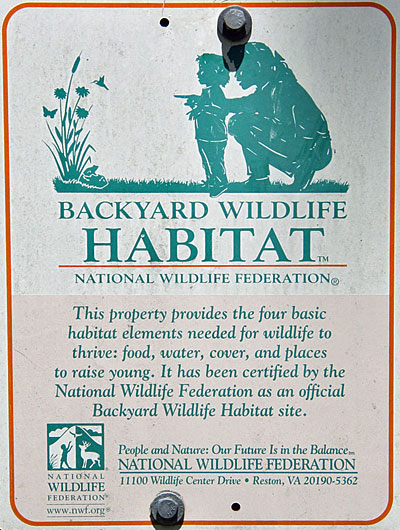 |
|
Ponds for Wildlife |
|
| Frogs Need More Than Just a Pond If you build a pond hoping to attract native frogs and toads, you should know that most California frogs and toads are not strictly aquatic. They enter the water mainly to breed then they leave to live on the land. The native frogs and toads that you could find in your yard in California have evolved to live on land when ponds are low or dried up. Their tadpoles change into frogs in one season. This means that they need suitable habitat on land as much or even more than they need standing water. If the most common and abundant frogs in the state, Pacific Treefrogs, have not discovered your pond, it might be because the conditions surrounding your property are not what they need to survive. All frogs and toads need suitable habitat around a pond. Some spend most of their life in moist shaded woodlands and only come to a pond to breed. If you build a pond to attract frogs, you are just as likely to attract non-native Bullfrogs as you are native frog species. Bullfrogs do stay in the water year-round, and they will make it difficult for other frogs to survive since they are voracious predators of anything smaller than themselves. (One way to get rid of bullfrogs is to empty the pond for part of the year. This will kill their tadpoles and force them to move away. However, more bullfrogs will probably return when you re-fill the pond.) Adding Frogs to Your Pond Putting wild or captive-bred frogs and toads in your pond without all of the necessary conditions for their survival will probably result in their demise. When they are put in an unfamiliar area, many frogs will immediately leave and try to find a way back to where they came from, which usually leads to their death by predators or when they cross a road. It is best to enhance your property to attract whatever frogs might naturally occur in your area and hope that "If you build it, they will come." Buying Frogs and Toads to Put in a Pond
People have asked me where they can buy native frogs and toads to put in their pond. It is commendable that they want to restore the habitat back to what it once was, but you should know that it is not legal to buy or sell most native reptiles and amphibians in California, and it is not legal to release captive wildlife into the wild. Any frogs or tadpoles you can buy legally will be non-native species, such as the invasive American Bullfrog, which is probably the frog most common in artificial ponds. But since the law also states that you cannot release captive herps into the wild, anything you buy must be kept in an aquarium or other enclosure. I doubt that an artificial pond can be considered an enclosure for captive frogs if the frogs could escape into the wild, but I'm not a lawyer. I don't know if anyone has been penalized for introducing native species into their property, but it could happen since it's against the law. Even if you could find a loophole to let you keep non-native frogs and toads in an outdoor pond or garden, do you really want to be responsible for the spread of another non-native species into the wild? You might try to find a neighborhood group that is re-populating native herps in your area, or contact the California Department of Fish and Wildlife for their advice. |
|
| Building a Frog-Friendly Pond The Spruce Pets 10/20/19 |
|
| How To Build a Wildlife Pond From Happy DIY Home 9/19 |
|
| Froglog An inexpensive device you can buy to help frogs and other animals get out of swimming pools they have fallen into. |
|
| Frog Conservation Project Backyard Ponds and Invasive Species in Arizona Why you don't want bullfrogs or crayfish in your pond |
|
| Aquatic Turtles and Outdoor Ponds Things to consider before you put a turtle in an outdoor pond. The Spruce Pets 2/12/19 |
|
| Frogs Face Ranavirus Risk in Garden Ponds Science Daily 6/3/15 A University of Exeter study published in June 2015 found that ranavirus, a disease which kills frogs, is more severe in ponds which contain exotic fish and in frogs which come into contact with chemicals used in gardens. |
|
| Froggy Fort - "The Frog Fortress is a modular habitat that adapts to your yard." It is "an innovative habitat...designed to revive native frog populations and restore ecosystems worldwide. | |
 |
 |
| © Patty Sliney This is a "toad house" designed and sold as a shelter for frogs and toads in the garden. You can buy them made in all sorts of fancy designs as you can see here, or you can make simpler ones on your own. A few of the many sites with instructions for making toad houses are here, here and here. Toad houses are designed to be placed in moist shady places, buried partly in the soil with leaves and other vegetation inside, in areas where toads may go to rest in the daytime. They can also provide moisture and shade in drier parts of the garden. If you have toads in your garden, they will probably use the shelter. If not, they probably won't attract toads, but you never know.… Be aware that in some areas they may also be used as a hiding place by snakes and other critters you might not care to encounter, so take caution when looking into a toad house. |
© Joel A. Germond This ceramic vat filled with water and plants makes a good small frog rookery, attracting Sierran Treefrogs to breed and lay their eggs in it. |
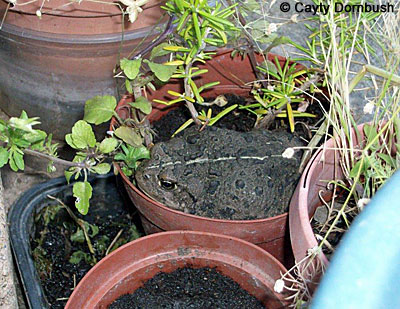 |
 |
| © Cayty Dornbush This fat California Toad inhabits a Calaveras County garden along with several others. |
© Joel A. Germond A male Sierran Treefrog calls from the ceramic vat seen above trying to attract a female to mate with. |
Plastic or Any Synthetic Netting Can Trap and Kill Small Animals |
|
When synthetic netting is used for erosion control or as a barrier to restrict the movement of animals, snakes and other small animals will try to crawl through the gaps in the netting then get caught and trapped because they can't break the strands. Unless they are cut loose, they will die from exposure, starvation, or they will get eaten by another animal. Even small-mesh metal chicken wire, which is much less flexible than synthetic mesh, can trap and kill snakes. Unfortunately, some synthetic commercial Snake Fencing is actually meant to trap and kill snakes this way. An alternative to synthetic erosion control netting is netting made of natural fiber such as jute that apparently is soft and flexible enough that snakes can break through it. Check out this internet herp forum report that describes and shows snake carnage that was the result of a large landscape netting project somewhere in the eastern part of the country. |
|
| Sometimes you can rescue an animal trapped in synthetic netting. Suzanne Camejo's success story is shown below. Here's another: In May, 2020, during the Covid 19 pandemic, a woman in Ojai emailed me a picture of a gophersnake trapped in some fine mesh netting in her yard. I told her the snake was harmless and suggested that she try to cut it out of the netting. That was at night, so she went back the next morning, found the snake still alive, and cut it out as well as she could, but the snake's mouth was filled with netting and she could not remove it. So she called an animal hospital. They referred her to a wildlife rescue center, which referred her to the fire department. (It's possible the hospital and rescue center were unable to help due to the stay-at-home situation. I suggest you call similar organizations for help before calling your local fire department which often has more important priorities.) Several men from the Ventura County Fire Department arrived and used tiny scissors to cut all of the netting out of the snake's mouth. Afterwards, the snake was moving with lots of energy and showed no signs of external wounds, so it was released into a field next door. Sometimes there is a happy ending, but only after much time and effort. It's easier to avoid using synthetic netting in the first place. |
|
 |
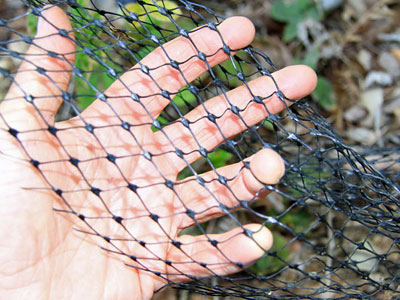 |
| Synthetic netting is often used on the ground for erosion control, as a trellis for climbing plants, or as a barrier to keep unwanted pests out of the garden, but it can pose a terrible threat to snakes, which become entrapped in the mesh and die. Do not use this netting in your garden if you want to coexist with your native herpetofauna. |
|
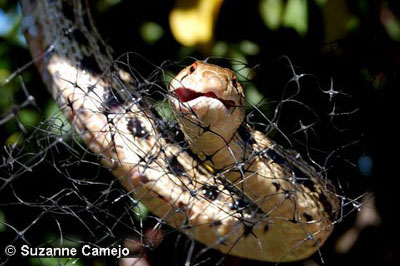 |
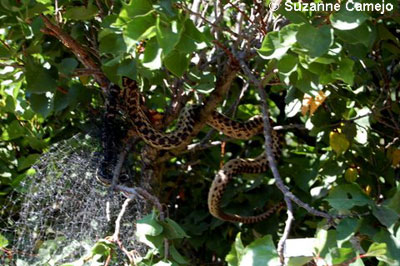 |
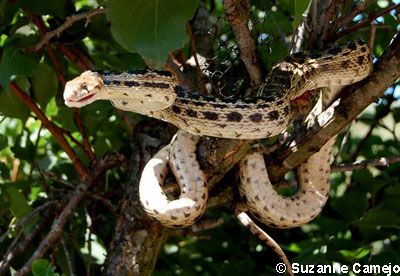 |
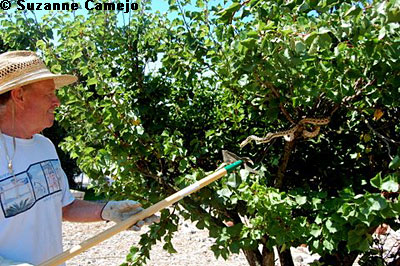 |
| © Suzanne Camejo Although synthetic netting is used as a natural method of pest control, it can be a hazard to some animals, especially snakes. Suzanne Camejo found this gophersnake in an apricot tree which it had climbed probably trying to raid a Mockingbird nest. The snake was entangled in synthetic netting used to protect the fruit from birds. Suzanne and her friends cut the netting, which had dug into the snake's skin, to free the snake. They were repaid with the hissing and striking of a very stressed-out snake, but one that was now free to crawl away and continue to rid the garden of rodents. |
|
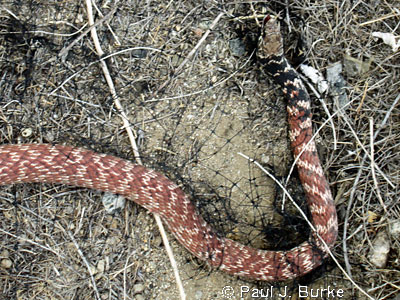 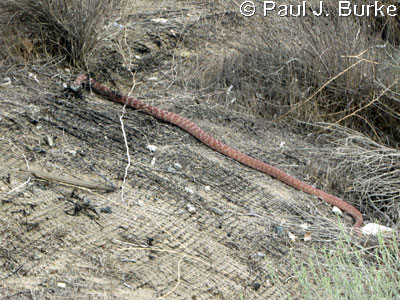 |
|
| © Paul J. Burke This Red Racer was found dead, entagled in synthetic netting laid on the ground as part of an abandoned landscaping project on a highway in Palmdale. |
|
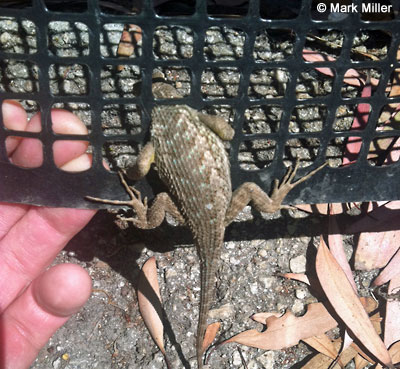 |
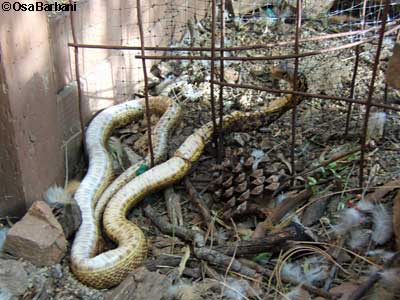 |
| Lizards, like this Western Fence Lizard can also get trapped in synthetic mesh including the synthetic mesh fencing that you see here. This one was rescued before it was too late. © Mark Miller | © Osa Barbani This gophersnake was found entangled in synthetic "wildlife netting" used as a barrier to rodents and other pests. After freeing two snakes that were found caught in the netting, the property owner removed the netting to protect the snakes. |
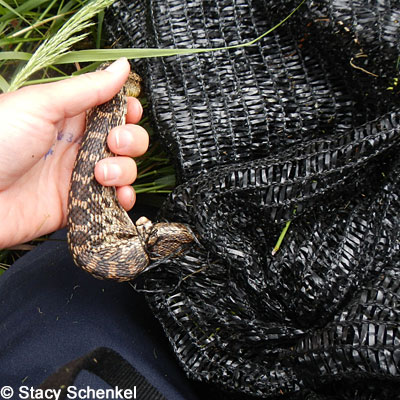 |
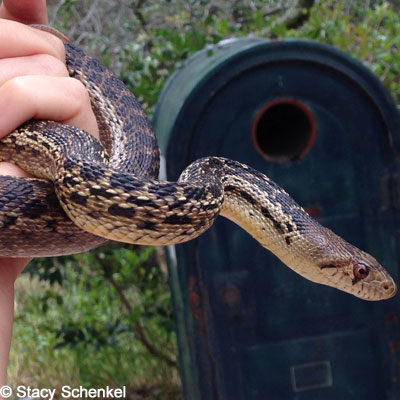 |
| This San Diego Gophersnake was rescued after it was trapped in a tarp with small mesh that was used to cover backyard stuff. Snakes will try to crawl through any open mesh, not just that used in plastic netting. © Stacy Schenkel |
|
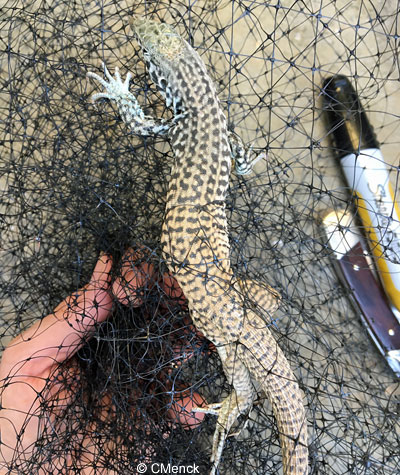 |
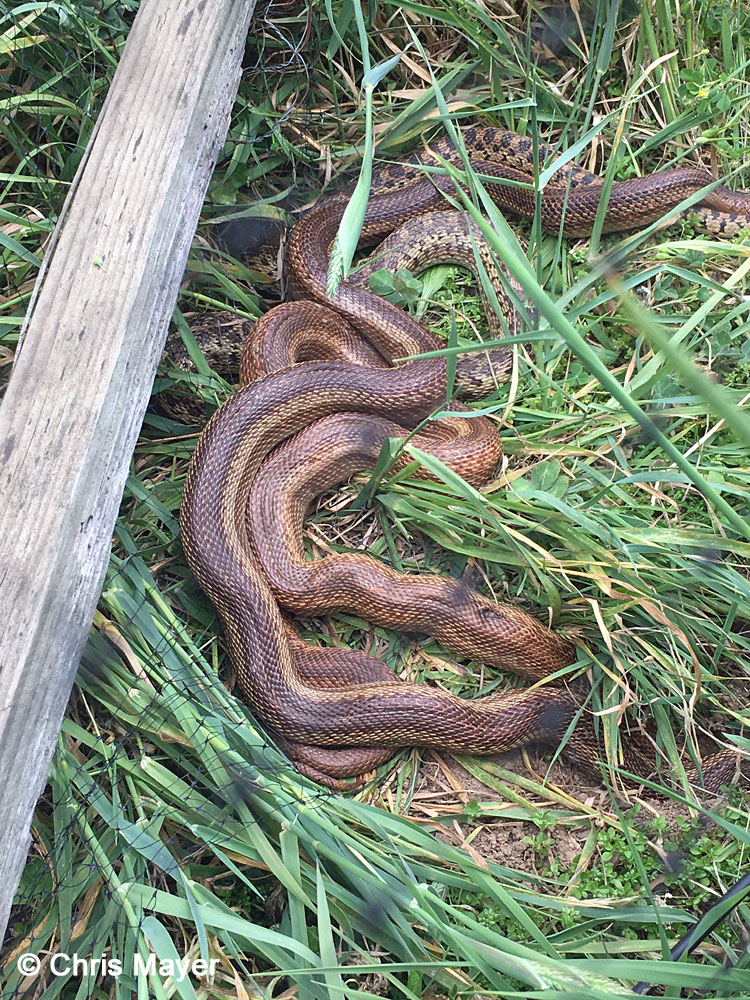 |
| CMenck found this adult trapped in some synthetic netting that was accidentally left on the ground in her desert yard. After cutting it out of the net, it went on its way and the net was removed. | These three mating gophersnakes were found caught in some netting that was raised to prevent this from happening but the wooden post holding the netting broke and fell to the ground. All three were found alive and cut free. |
Glue Traps Can Accidentally Trap and Kill or Injure Reptiles and Amphibians |
|
Glue traps, glue boards, roach traps, sticky traps, mouse traps, whatever they are called - any kind of trap that uses sticky glue to catch mammals and insects can also trap herps. Some glue traps are even sold as snake traps. Glue traps are indiscriminate killing devices that can cause animals to die slow, painful, terrible deaths. Some of them even chew off their own limbs trying to escape. Many of them are not even the intended victims. The Humane Society of the United States discourages the use of glue boards calling them "cheap, cruel, and indiscriminate" and "ineffective, inhumane, and dangerous." The Humane Society webpage about glue boards recommends that you consult a trained professional wildlife rehabilitator or veterinarian if you find an animal caught on a glue board. For times when that is not possible, they include instructions on how to use cooking oil to remove an animal from a glue trap. The website Living Alongside Wildlife also includes instructions on how to remove a snake from a glue trap, but you will have to search for it. |
|
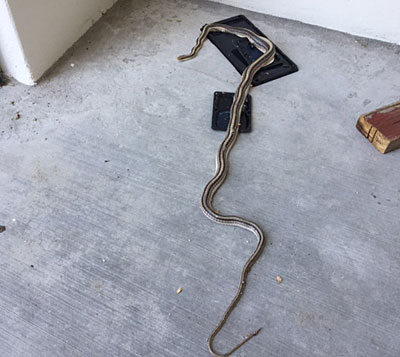 |
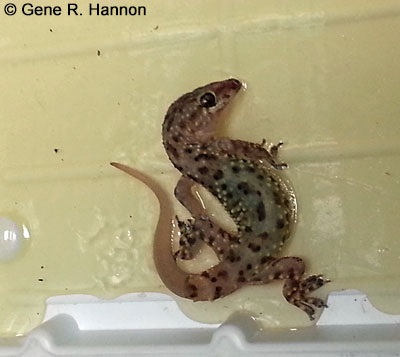 |
| This Baja California Patch-nosed Snake was accidentally trapped in a trap meant for mice and rats. It was found alive but unable to free itself. | This Mediterranean Gecko, an alien species, was found in a sticky trap in Fresno. © Gene R. Hannon |
Learning to Live With Wildlife |
|
Living With Wildlife - California Department of Fish and Wildlife What to do about nuisance, dangerous, orphaned or injured wildlife. Advice for common human-wildlife interactions. And more. |
|
| Living With Wildlife - Frogs This Washington Department of Fish and Wildlife page has some excellent information about living with frogs in your pond and on your property that will be helpful in California, too. |
|
| Living With Wildlife - Snakes Another good Washington Department of Fish and Wildlife page with good information on Tips for Attracting Snakes , including diagrams for building snake shelters - a rock pile and a snake board. Another section offers information about Preventing Conflicts With Snakes. |
|
| Living Alongside Wildlife - A natural history of the fascinating animals that share our landscapes - Dr. David A. Steen's blog about coexisting with wildlife, with a focus on herps. |
|
| Wildcare is an urban wildlife rehabilitation center based in the Bay Area, that offers education about living with wildlife, a Living With Wildlife telephone hotline, and a wildlife rehabilitation hospital. |
|
| Lyme Disease and Lizards Los Angeles Murray Susser, MD's Blog PostIn this blog the doctor is advising people not to put lizards in their yard to help protect them from contracting Lyme Disease, because it doesn't work. He is not advising people to remove all lizards from their yard. |
|
Coexisting With Snakes |
|
| How to Safely Coexist with Snakes - Florida Museum of Natural History Information about dealing with Florida's snakes which is also useful for California snakes. Includes illustrations on how to capture a snake in a garbage can in a way that is safe for both human. and snakes. |
|
| Living with Wild Snakes - The Northern California Herpetological Society |
|
| Learn to Coexist with Snakes - Save the Snakes |
|
| Living With Snakes - Advocates For Snake Preservation |
|
| Building a Snake Hibernaculum - From the Toronto Zoo. |
|
| Artificial Hibernacula Respectthesnake.com documents the building of arfificial hibernation structures for the Lake Erie Water Snake at an Ohio State Park. |
|
| The Idyllwild Antivenom Group If you live near the San Jacinto Mountains in Southern California, the Idyllwild Antivenom Group offers antivenom for pets who have been bitten by the Southern Pacific Rattlesnake and information about pets and rattlesnakes. |
|
Keeping Snakes Off of Your Property |
|
National Wildlife Federation: Eliminating Snakes In Your Yard The NWF provides this web page which discusses what you can do to try to keep snakes away from your property, and why there really is no need to do so. Keeping Snakes Away: Advice from a Wildlife Biologist - From the Field Ecology blog, 6/17. Tips Bulletin has a page titled 9 Simple Ways to Keep Snakes Out of Your Yard. |
|
Snake Relocation Services (Snake Removal / Rattlesnake Removal, etc.) |
|
Some people want to have someone remove a snake from their property instead of trying to remove it or kill it themselves. Often the snake is harmless, but they want it removed anyway. There are professional reptile relocators in the state that you can find and contact. There is also a good list available here: Melissa Kaplan's List of Reptile Relocators in California. There is also a Facebook Free Snake Relocation Directory and a Google Map of snake relocators all over the country. |
|
Rattlesnakes |
|
The only dangerously venomous (poisonous) snakes naturally found in California are rattlesnakes. Below is a collection of links I have assembled to help you deal with living around these dangerous snakes. There is more information about rattlesnakes on my Living With Rattlesnakes page. |
|
|
Living With Rattlesnakes California Department of Fish and Wildlife: Rattlesnakes in California University of California: Rattlesnakes Management Guide Florida Museum of Natural History: How to Safely Coexist With Snakes The Tucson Herpetological Society: Living With Venomous Reptiles Washington Department of Fish and Wildlife: Living With Snakes Centers for Disease Control and Prevention: Venomous Snakes Anapsid.org: Melissa Kaplan's Rattlesnake Information Page Southwestern Field Herping Association: Venomous Snake Safety The Rattlesnake Conservancy - Advancing the protection of rattlesnakes and their habitat through research and education Snake Bites California Poison Control System (search for "rattlesnake bite") UCI Health - What to do if you're bitten by a rattlesnake Snakebite Safety! How to Effectively Avoid, Identify, and Treat a Snake Bite (Includes all of the U.S.A.) Don't Use Snakebite Suction Devices : Snakebite Suction Devices Don't Remove Venom: They Just Suck (Sean P. Bush, MD - Annals Of Emergency Medicine 43:2 pages 187-188 February 2004.) Bay Nature Magazine - Are Baby Rattlesnakes the Most Dangerous Biters? The Amazing Story of Andy Cat - a very lucky pet cat who was bitten by a rattlesnake and survived, thanks to the smart actions of its owners. Wikipedia List of Fatal Snake Bites in the United States |
|
Rattlesnakes and Your Pets |
|
Rattlesnake Avoidance Training For Dogs |
|
| Dogs are not naturally afraid of rattlesnakes, so dogs who live in rattlesnake country are at risk of being bitten by rattlesnakes due to a surprise encounter or their own curiosity. You can't prevent all surprise encounters, but dog owners can pay to have their dogs trained to keep them from walking up to investigate a rattlesnake with what is called Rattlesnake Avoidance Training. Dogs are trained to avoid live snakes, snake scent, and the sound of a rattlesnake rattle. Some people think this training is inhumane and traumatizes the dogs because it uses electrical shock collars to shock the dog when it gets near a snake. Some say that it's cruel to the rattlesnakes that have their mouths taped or muzzled to avoid them biting the dog. To avoid traumatizing a dog, trainers can use different types of collars, including spray collars that use canned air, vibrating collars that feel like a cell phone vibrating, as well as low-intensity electrical shock collars. Organizations like the Humane Society offer the training for a price, as do private companies such as Natural Solutions that sells a training service in Southern California that they call Rattlesnake Aversion Training. There are other companies that sell the service that you can find online, and you can also search for YouTube videos about the training. I can't recommend or warn against rattlesnake avoidance training since I have no personal experience with it. I have heard from dog owners whose dogs were trained but failed to avoid rattlesnakes, and from other dog owners who said the training works very well. One person told me his dog failed its first training, so he had it trained a second time with positive results, so more than one training may be necessary depending on the dog. Animal experts recommend that once the training is completed, dog owners should not automatically assume that their dog will always avoid snakes, but should watch the dog carefully to make sure the training worked. |
|
Rattlesnake Vaccines For Dogs |
|
| There are a number of companies that offer vaccinations for dogs in order to protect them from rattlesnake venom. I have not researched the validity of their claims so I can't endorse them. You will need to figure out on your own if the vaccines work and if they are worth the trouble and the expense. I used to have links here to companies that offered information about vaccinating dogs but their web pages have been taken down. |
|
 |
|
| The inspirational Story of Andy Cat - a cat who was bitten by a rattlesnake and survived, with before, during, and after photos. Some pets die from a rattlesnake bite, but this cat is one of the lucky ones, thanks to the smart actions of his owners. There are some very good tips here that might help you if your pet is bitten by a venomous snake. |
|
| Pets as Herp Predators | |
CatBib A device that interferes with a domestic cat's ability to catch birds. It probably stops them from catching herps, too. Your cat will probably pee in your shoes if you put on on it, but your yard lizards will love you for it. |
|
Traveling Turtles Do Not Always Need To Be Rescued |
|
| You don't need to pick up a turtle to rescue it just because you find it walking on land, even if it is not near water or it is in an area where you think it does not belong. |
|
| If you see a turtle crossing a busy road or stopped in the middle of a road, if it is safe for you to do so, you should move it to the side of the road in the direction it was going, then leave it there. That is probably all the help wild turtles ever need from humans. If you see a turtle walking on land, it is probably not sick or lost. Turtles do not spend their entire time in the water. In the Spring, many female turtles can be found traveling on land looking for a suitable place to lay their eggs. Turtles also walk on land looking for food, mates, or a better place to live, so the best thing to do if it's not in immediate danger is to let it go on its way. Many well-intentioned people think they are helping a turtle by picking it up and bringing it to a wildlife rehabilitation center, or putting it somewhere they think is a better place for it, but they may actually be harming it by removing it from the wild unnecessarily or moving it away from an area where it is established and where it has learned how to survive. |
|
Wildlife Rehabilitation Facilities |
|
| If you find a herp that is sick or injured, the California Department of Fish and Wildlife has published this list of wildlife rehabilitation facilities, some of which may be able to take reptiles and amphibians: https://www.wildlife.ca.gov/Conservation/Laboratories/Wildlife-Investigations/Rehab/Facilities |
|
Human Efforts to Protect Traveling Reptiles and Amphibians |
|
| Some communities have built road crossing culverts - tunnels with fences to guide reptiles and amphibians to cross under a road instead of over the road where many of them have been killed by traffic during their annual migrations. Below are links to a few of these. In other places, roads are closed in migration season or warning signs are used. These are a few of those efforts, and there are many more. | |
Cotati California Tiger Salamander Tunnel - The Press Democrat, January 15, 2013 |
|
| Amherst, MA Salamander Migration Tunnels - The Hitchcock Center for the Environment | |
| New Monkton, Vermont Salamander Crossing Culverts - Burlington Free Press, March 28, 2016 | |
| Waterton Lakes National Park Salamander Crossing Tunnels - Parks Canada | |
| The SPLAT Project Amphibian Tunnel in B.C., Canada - http://splatfrogtunnel.blogspot.com/ | |
| Guelph, Ontario, Canada Underground Frog Crossing Tunnel - ElliotLakeToday.com Dec. 5, 2017 | |
| Turtle Undercrossing in Portage County, Wisconsin - Wisconsin Public Radio, July 10, 2019 | |
| Burlington, Ontario, Canada closes a road every March to April to protect the breeding season migration of endangered Jefferson Salamanders. - Burlington Post | |
| Effectiveness of small road tunnels and fences in reducing amphibian roadkill and barrier effects at retrofitted roads in Sweden - Peer J 8/26/19 "In mitigated road sections, the estimated number of amphibians killed or at risk of being killed by car traffic decreased by 85–100% and the estimated number successfully crossing the road increased by 25–340%." |
|
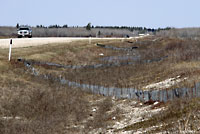 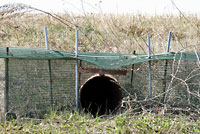 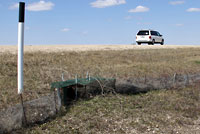 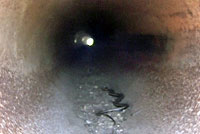 |
|
| Snake Crossing Culverts at the Snake Dens in Narcisse Canada Built to Protect Migrating Gartersnakes | |
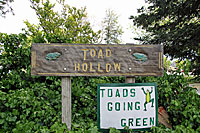  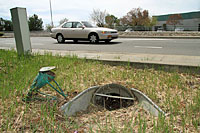 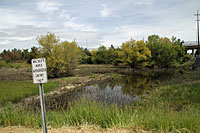 |
|
| Toad Hollow Tunnel Built to Protect Migrating Toads in Davis, California |
|
| The Chileno Valley Newt Brigade was organized to help ferry migrating newts across a road in Marin County. | |
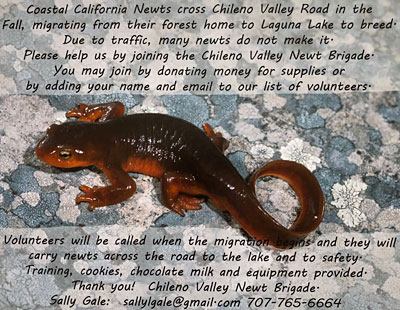 |
|
| The Chileno Valley Newt Brigade was formed in August, 2019 to assist newts crossing Chileno Valley Road on their way from their hillside home to Laguna lake, where they breed. Laguna lake, a large natural lake in the agricultural section of West Marin, is bordered by Chileno Valley Road, which cuts the newts off from the leaf littered, shady hillside where they live during the summer. When the weather turns humid and drizzly in the Fall, the newts venture onto the road, putting themselves in the path of cars and trucks. Newts crawl slowly and freeze in incoming traffic, placing themselves in mortal danger. A simple low cost solution to the newt’s plight is having people pick up the newts and carry therm across the road. This is the simple goal of the Chileno Valley Newt brigade. However, many more volunteers are needed for this task. Please join us by contacting Sally Gale at sallylgale@gmail.com to sign up. |
|
| Other efforts to protect migrating newts have been attempted at Lexington Reservoir in Santa Clara County, and at Tilden Park in the Berkeley Hills, where a road has been closed each winter for many years. |
|
 |
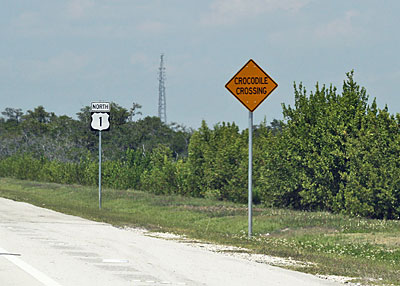 |
 |
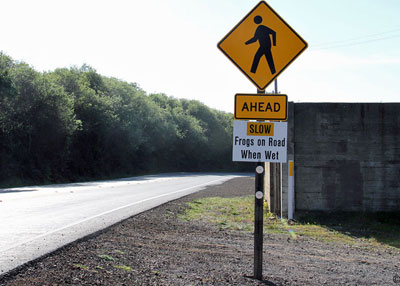 |
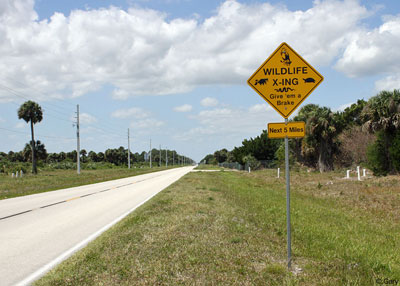 |
 |
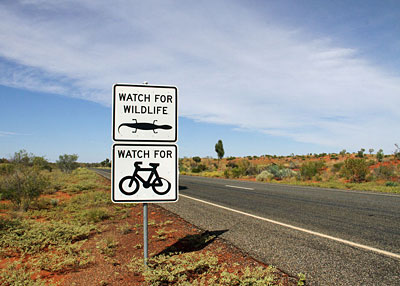 |
 |
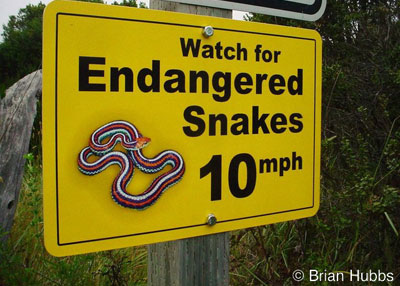 |
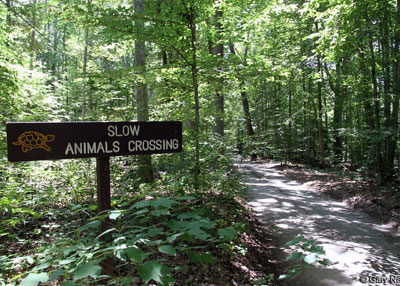 |
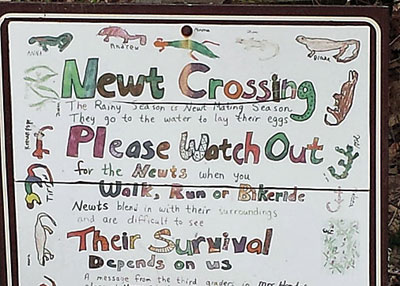 |
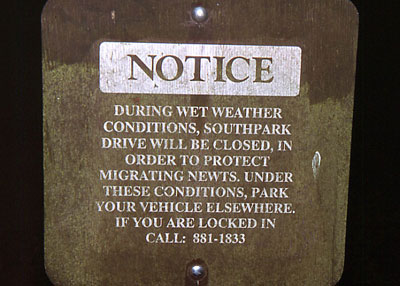 |
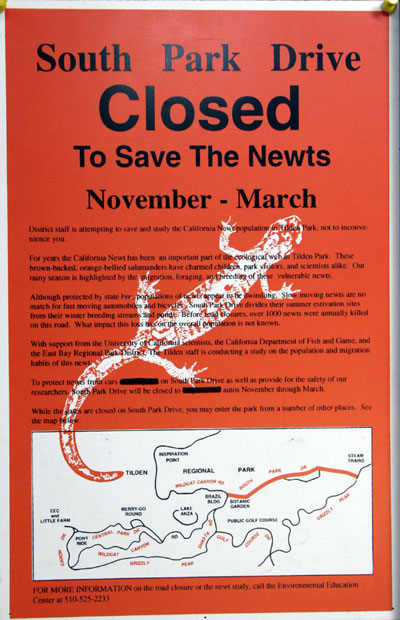 |
 |
|
|
Herps That Might Be Found In California Yards |
|
These are some of the more common reptiles and amphibians that have been found living around humans in California, typically in yards in the more-populated areas of the state. People who live in less-populated areas such as the north coast, the deserts, the central valley, etc. may have other species that are not listed here. If you find one that is not on the list, let me know. |
|
| Snakes | |
Gophersnakes - This is probably the most common yard snake in the state, found almost anywhere. California Kingsnakes - Have been found in yards near open space. Gartersnakes - Have been found swimming in swimming pools and fountains in Sonoma and San Diego Counties. Found in yards on the north coast. Northern Pacific Rattlesnakes - Sometimes found in yards, often in areas where new housing developments have encroached on rattlesnake habitat. Southern Pacific Rattlesnakes - Sometimes found in yards near open spaces. Red Coachwhips - Often seen in yards near open space, especially in desert communities. Ring-necked Snakes - Found under debris in moist shaded areas. Sharp-tailed Snakes - Found under debris in moist shaded areas in yards in Northern California. Most reports I've had are from the East Bay and the foothills area east of Sacramento. Threadsnakes (Blindsnakes) - Occasionally found on wet pavement in San Diego County. I received a report of one crawling on someone's kitchen floor. A non-native species, the Brahminy Blindsnake, is becoming more common in yards in coastal Southern California. |
|
| Lizards | |
Western Fence lizards are probably the most common yard lizard in the state, often seen basking on fences and walls. Alligator lizards are probably the second most common yard lizard, especially in southern California where they sometimes live in garages and enter homes. Side-blotched lizards - Found in desert communities and semi-arid areas. Granite Night Lizards - Have been found living on houses in San Diego and Riverside Counties, where they eat insects attracted to lights, similar to geckos. Mediterranean Geckos - This non-native gecko has been found living in and on houses throughout southern California and the Central Valley and it is spreading rapidly. Long-tailed Brush lizards - Found on suburban vegetation in the Palm Springs area, and probably in other desert communities. Legless lizards - Sometimes found in gardens and leaf litter, mostly in southern California. Anoles - Non-native species. Reports of Green Anoles and Brown Anoles seen in southern California yards are increasing. |
|
| Turtles | |
Red-eared Sliders - Sometimes found in artificial ponds. |
|
| Frogs and Toads | |
California Toads - Found in yards in many locations around the state, although not as many as there used to be. They are attracted to areas with lawn sprinklers. Some isolated desert locations where they have been found are California City, Borrego Springs, and Ridgecrest. These similar frogs were considered all the same species once. They are often heard more than seen. Northern Pacific Treefrogs - Often found in yards on the far north coast, entering ponds and other standing water to breed. Sierran Treefrogs - Found in wet yards and ponds throughout the northern part of the state. Baja California Treefrogs - Adults and tadpoles are found in and around southern California ponds, and sometimes swimming pools. Bullfrogs - A non-native species that is nevertheless found in artificial ponds over most of the state, and sometimes even in swimming pools. Northern Red-legged Frogs - Found in ponds and yards along the north coast. California Red-legged Frogs - Found rarely in ponds on rural property in the East Bay. Western Spadefoots - They are not common, but they have been found in yards or pools during the rainy season in less-developed areas. |
|
| Salamanders | |
California Slender salamanders - Common in yards in the Bay Area and north coast. Often mistaken for worms. Garden Slender Salamanders - Common in yards in Los Angeles, San Diego, Orange, and Riverside Counties. Often mistaken for worms. Arboreal salamanders - Often found in yards in the San Francisco Bay Area and sometimes inside garages and basements. Sometimes seen climbing on sidewalks and on walls on rainy nights. California Giant Salamanders - Sometimes found in yards near forested areas along creeks in the Santa Cruz Mountains and in Marin County during rainy weather. Northwestern Salamanders - Found under debris in wet areas along the north coast. Rough-skinned Newts - Found under debris or in ponds along the north coast. |
|
| Pictures of a Few Herps That Were Encountered by Humans and Their Pets in Houses, Yards and Gardens | |
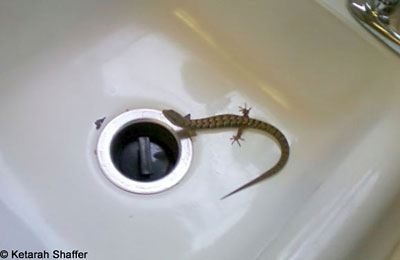 |
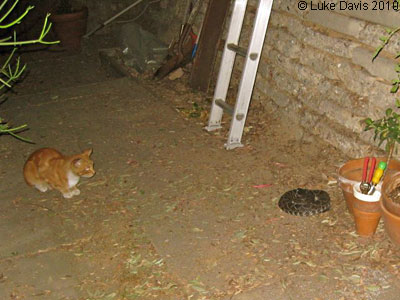 |
| Southern Alligator Lizards are fairly common in suburban yards and gardens, especially in Southern California, and occasionally they enter garages and even houses as they wander around looking for food or water or mates, but this is the first one I've seen that was able to climb up a kitchen counter and fall into a sink. © Ketarah Shaffer |
© Luke Davis Rattlesnakes are often unwanted yard visitors that can pose a threat to your pets and to you. This cat was very lucky not to tangle with this Southern Pacific Rattlesnake. Look above or on this page for some links to information about dealing with rattlesnakes on your property and rattlesnakes and your pets. |
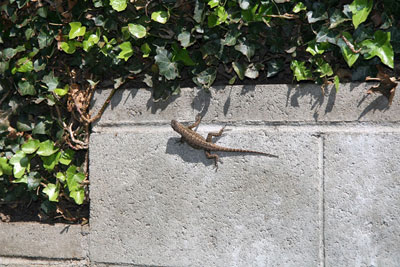 |
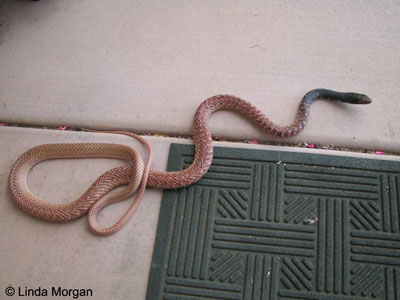 |
| Western Fence Lizards are common in yards in many areas of California. | © Linda Morgan This Red Racer (or Coachwhip) was a surprise visitor to a back porch in San Diego County. |
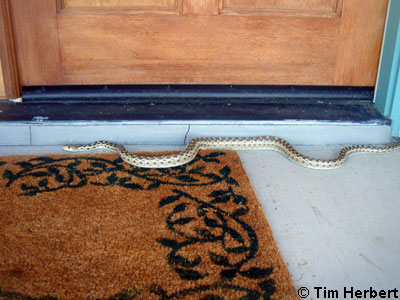 |
 |
| © Tim Herbert This harmless Pacific Gopher Snake was an unexpected surprise when it showed up on the porch one day. |
© Sean Kelly Sometimes herps are seen in around swimming pools, including frogs and some species of salamanders that become aquatic and breed in the water. Most of them probably fell in and could not climb out. This Western Skink was scooped out of a pool that it had fallen into. |
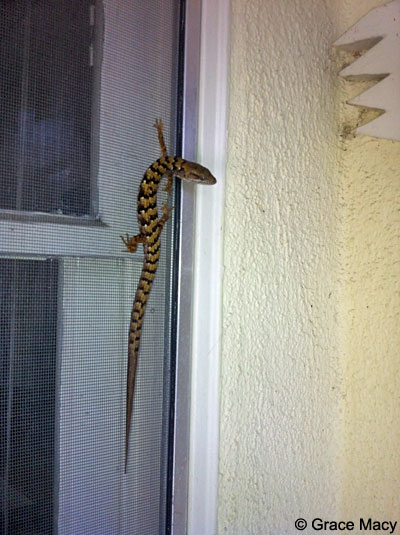 |
 |
| © Grace Macy Imagine coming home to find this big Southern Alligator Lizard on your screen door! |
© Debbie Frost These Sierran Treefrogs found a comfortable resting spot above a front door where they return each day. Click on picture for a wider view. |
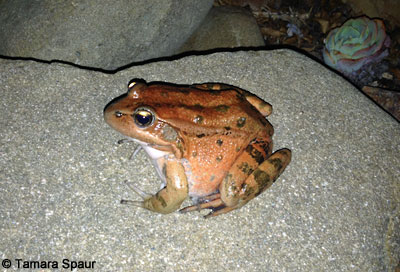 |
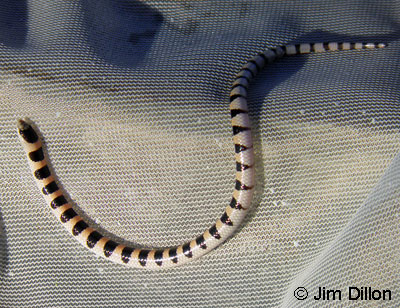 |
| This California Red-legged Frog made herself right at home at a backyard Koi pond, returning every night to sit and wait for food. © Tamara Spaur |
This little juvenile Mohave Shovel-nosed Snake was found in a swimming pool in a desert community near Palms Springs. © Jim Dillon |
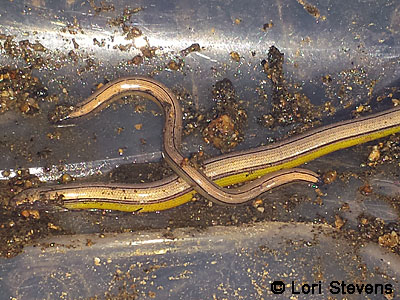 |
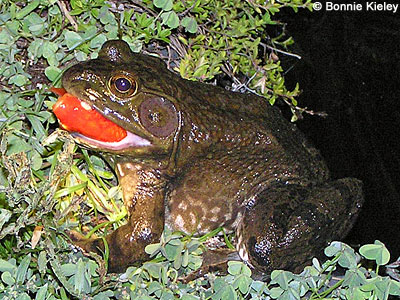 |
| Legless lizards are often found in Southern California gardens under bushes, ground cover and leaf litter with loose soil. This adult and juvenile were found in a lush overgrown yard shaded by huge pine trees when an old oleander stump was removed. © Lori Stevens |
This American Bullfrog, swallowing a goldfish, has taken up residence in the goldfish-stocked artificial ponds in a Tehama County yard. © Bonnie Kieley |
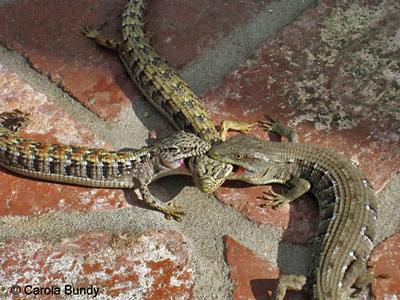 |
 |
| © Carola Bundy Two male Southern Alligator Lizards were spotted claiming the same female on a back porch in Los Angeles County. |
A juvenile Mediterranean Gecko walks on a glass window. |
 |
 |
| © Carrie Galvin A freeloading American Bullfrog catches some rays in pool in El Dorado County that does not have any chlorine in it, where it has returned for three consecutive winters to be the pool's only resident. |
In winter, Northern Red-legged Frogs enter this artificial pond on the Humboldt County coast to breed and lay eggs. |
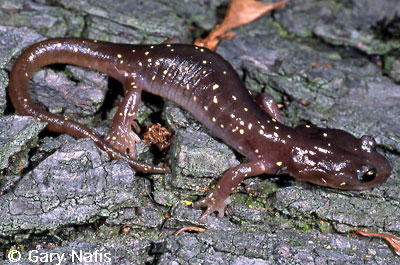 |
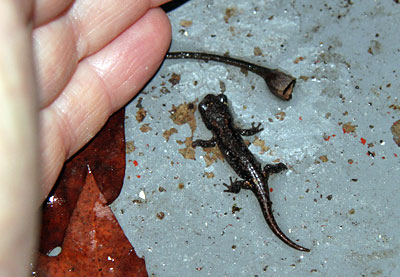 |
| Arboreal Salamanders are common but secretive residents of some yards, especially in the Bay Area. They usually wander around only on rainy nights, so they often go unnoticed. This one lived in an underground garage in Oakland. | This tiny Arboreal Salamander was photographed in a Marin County yard in early February. These salamanders are not uncommon in moist yards in the SF Bay Area, along with California Slender Salamanders. |
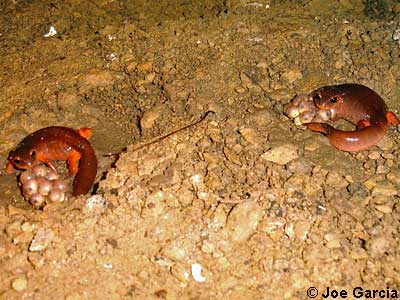 |
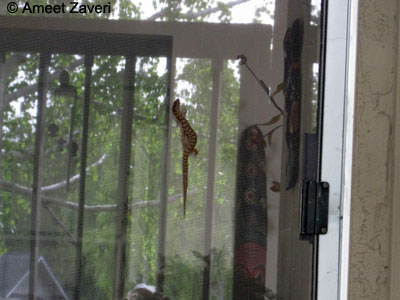 |
| © Joe Garcia These female Monterey Ensatinas were found brooding their eggs underneath a wet rotting board that was under a house in Monterey County. |
© Ameet Zaveri This Southern Alligator Lizard is climbing up a screen door in Alameda County. |
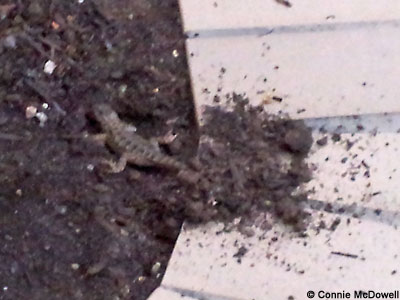 |
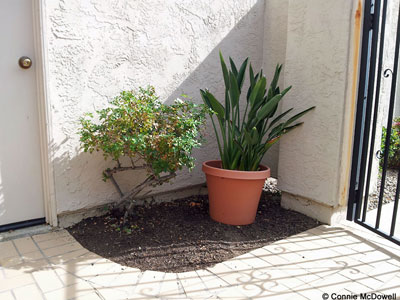 |
| A female fence lizard lays her eggs in a nest she dug on a San Diego County patio in mid June. © Connie McDowell If you are fortunate to discover nesting activity like this, it is probably best to continue with your usual gardening activities. Since the female chooses a location where the moisture and temperature will be good for her eggs to incubate (for 60 days in this case.) If you alter your watering habits or try to protect the eggs by covering them with something solid (a screen might work) or with extra dirt, they might not hatch. Just try not to step on or dig up the spot until they hatch. (And tell your cats and dogs to do the same.) |
|
 |
 |
| © Deb Barringer This large gophersnake wandered across a suburban front yard full of rodent burrows. |
© James Rowe This California Kingsnake found resting on some stairs on a cool evening was harmless but delivered quite a shock to a miniature long-haired dachshund. |
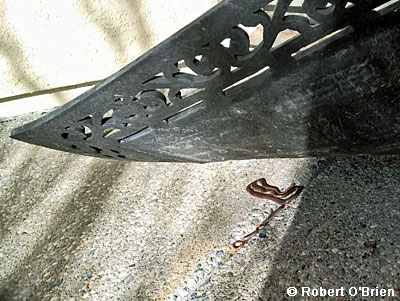 |
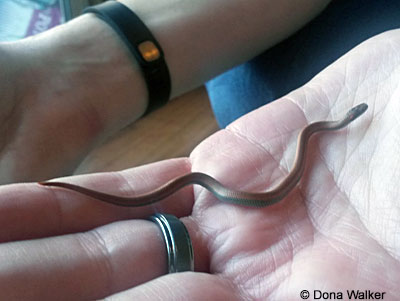 |
| © Robert O'Brien In some areas of the state, Common Sharp-tailed snakes are sometimes found around houses and yards and garages. The snakes in this picture were found hiding under the front door mat of a northern California house. Occasionally I receive pictures of sharp-tailed snakes found inside a suburban house. My guess is that because of their small size and tendency to look for dark places to hide, they squeeze their way inside a house under a door then become disoriented and can't find their way back outside once they realize they are not in a hospitable environment. |
This juvenile Common Sharp-tailed Snake was found inside a northern California garage in January. © Dona Walker |
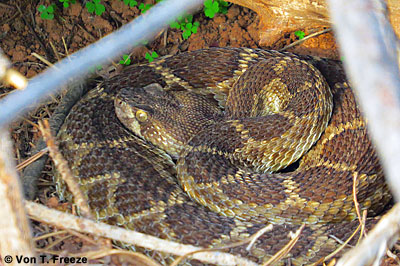 |
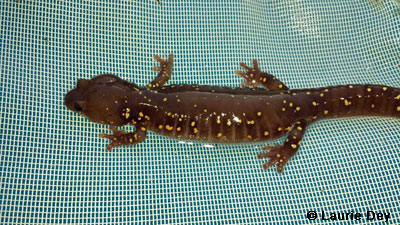 |
| © Von T. Freeze This rattlesnake must have been a surprising find in the yard in March. |
© Laurie Dey This adult Arboreal Salamander was rescued from the bottom of the deep end of a swimming pool. |
 |
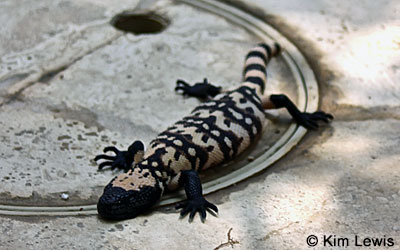 |
| © Sean Kelly This Rosy Boa was found basking on a driveway in San Diego County. |
© Kim Lewis |
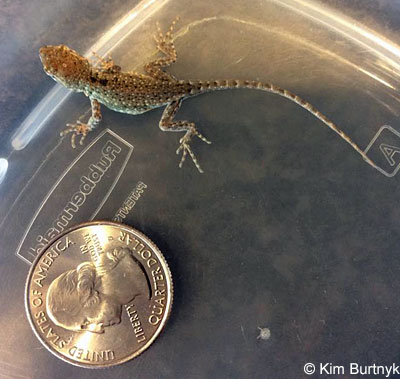 |
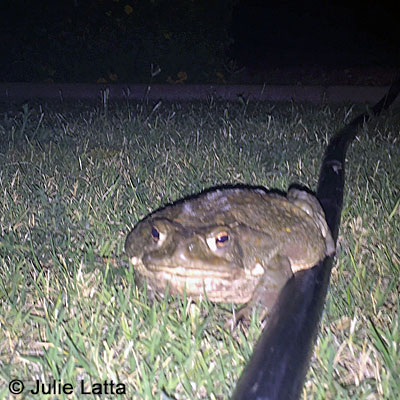 |
| This tiny hatchling side-blotched lizard was found inside an office lobby. © Kim Burtnyk | Sonoran Desert Toads have disappeared from California, but they're very common in much of Arizona, especially after the summer monsoon rains begin. At that time, they are often seen in yards such as this one near Phoenix. © Julie Latta |
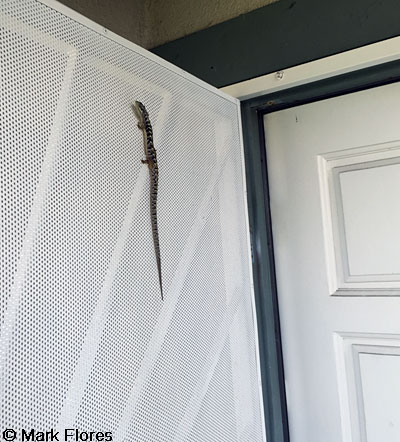 |
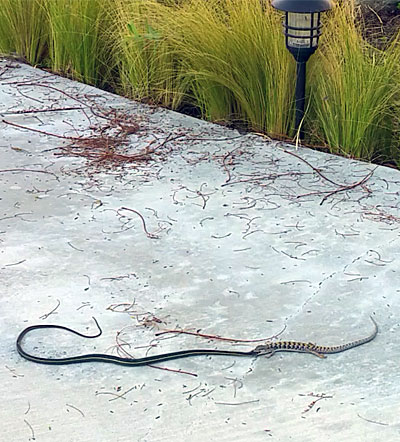 |
| This large Southern Alligator Lizard was found climbing up a metal security door. @ Mark Flores |
A homeowner was fortunate to witness an epic battle on her driveway between a Southern Alligator Lizard and a California Striped Racer that was probably trying to eat the lizard when the lizard defended itself by biting onto the snake. |
 |
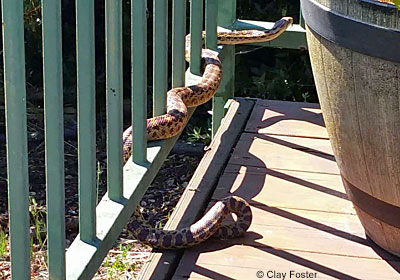 |
| During the dry period, roughly from June to October, Arboreal Salamanders hide out in cool moist areas, usually underground, sometimes even in basements and underground garages. This one was found underneath the circular base of a large statue in a Santa Clara County backyard in August. © Laurie Weber |
This large adult Pacific Gophersnake was a shock to find crawling on a deck in San Jose. © Clay Foster |
 |
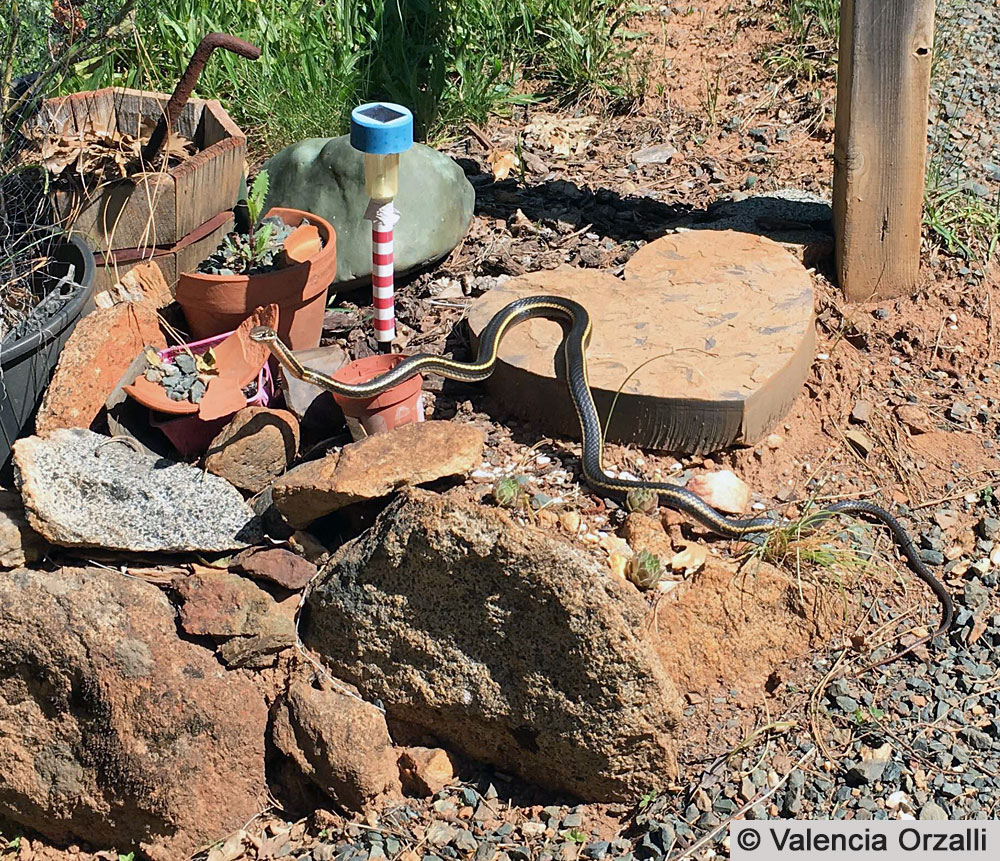 |
| This wild Green Anole was found in the house trying to get out the cat door. Fortunately I found it before the cat did and put it outside. | This California Striped Racer was found in a garden in Nevada County. |
 |
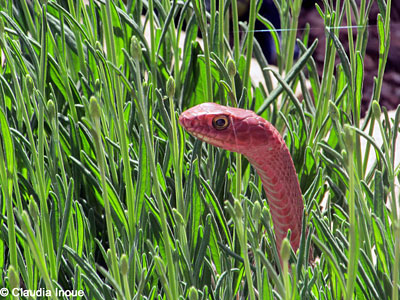 |
| This Western Coachwhip lives and hunts by a front door in Santa Fe. © Claudie Inoue | |
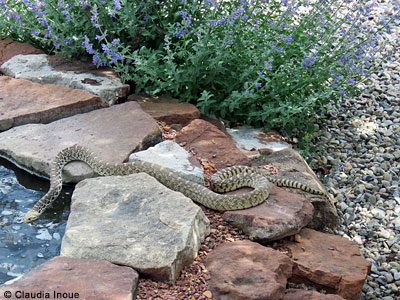 |
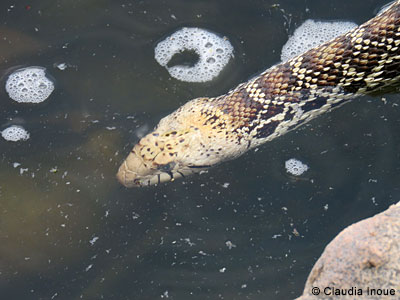 |
| This Bullsnake likes to drink water from an artificial pond in a Santa Fe yard. © Claudie Inoue | |
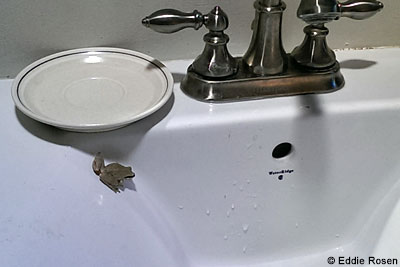 |
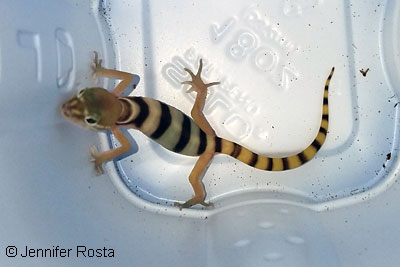 |
| Treefrogs sometimes like to hang around sinks and showers in houses, like this Sierran Treefrog in Sonoma County. © Eddie Rosen |
People who live in communities the desert often find desert species on their property. This baby Desert Banded Gecko was found in a desert greenhouse. © Jennifer Rosta |
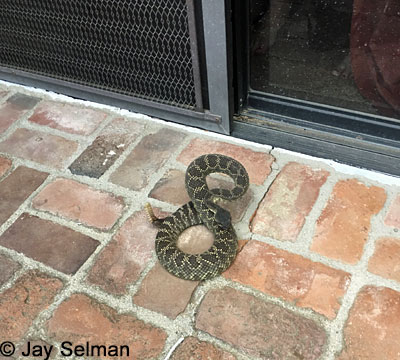 |
 |
| A dangerous snake on your doorstep, like this rattlesnake, is not a welcome sight to most people. Check this page for some links to information about dealing with rattlesnakes on your property. © Jay Selman |
In populated areas in the desert such as the Coachella Valley and Palm Springs, desert lizards often live in planted and irrigated yards. The Long-tailed Brush Lizard has evolved to live mostly on creosote bushes, but it can also live on trees and other vegetation, including exotic yard plantings such as this Cape Honeysuckle. © Dan Schroeter |
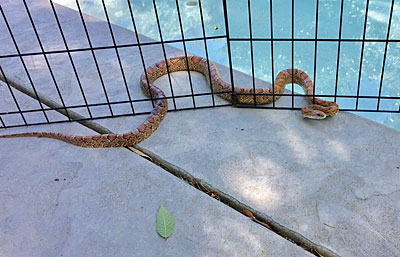 |
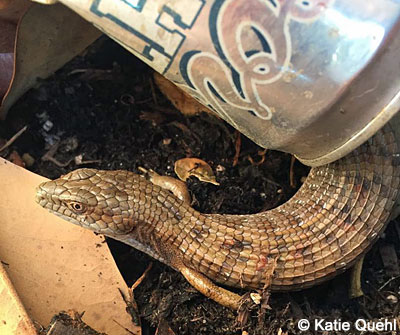 |
| This escaped pet Corn Snake has inhabited a Sacramento backyard for more than a year, and sometimes comes out to lounge by the pool. | Wildlife are often injured by or trapped in our garbage. This Southern Alligator Lizard was found stuck in a beer can, unable to get out. © Katie Quehl |
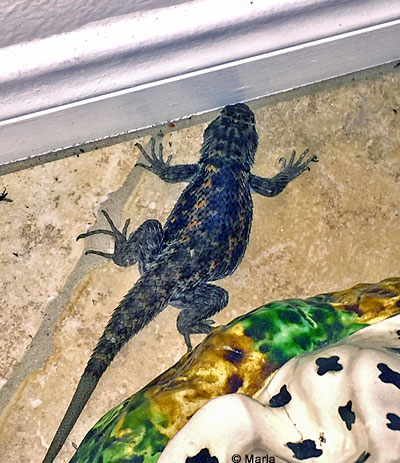 |
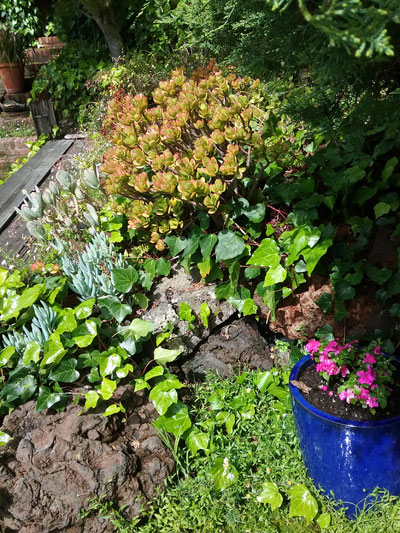 |
| This large male Desert Spiny Lizard was found in a family room in Rancho Mirage. © Marla | A Western Skink and a Western Fence Lizard are seen here basking together on a rock in a spot they regularly return to in a garden in Marin County. I don't know why two different species tolerate each other like this, but it's one of the many aspects of herp behavior you might be lucky to observe in your yard. |
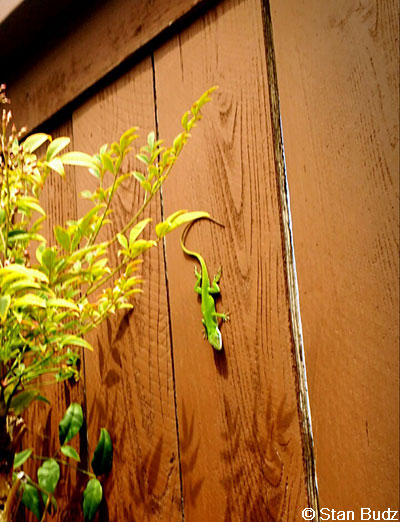 |
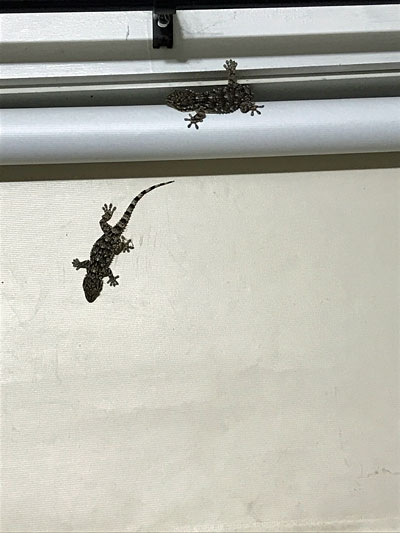 |
| More and more homeowners in Southern California are seeing these green lizards on their property. They're Green Anoles which are not native to California but are spreading around vegetated areas of the southland. © Stan Budz | Another alien lizard that is being reported being seen now, mostly from yards and houses in San Diego County and especially El Cajon, is the Moorish Gecko. |
 |
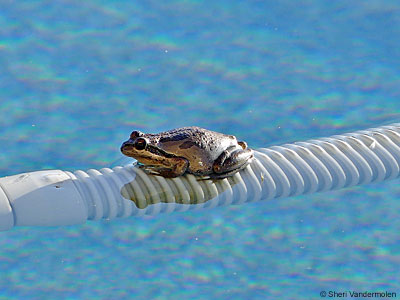 |
| The Mediterranean Gecko is now being found through much of the warmer parts of the state of California. It is frequently found on walls outside and inside the house. It is especially fond of sitting under lights on outdoor walls at night where it hunts for flying insects that are attracted to the light. | Sometimes frogs are attracted to swimming pools. This Baja California Treefrog was observed on a pool-vacume hose. © Sheri Vandermolen |
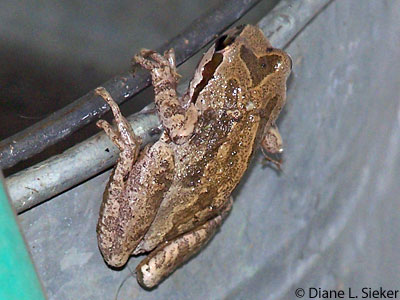 |
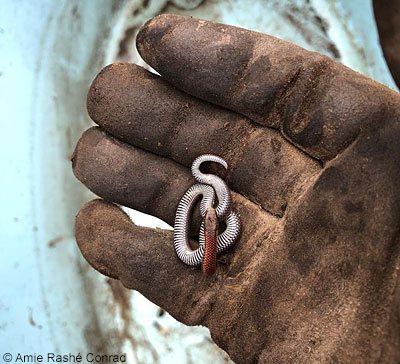 |
| This Baja California Treefrog showed up on a back porch one night in Riverside County. © Diane L. Sieker |
Common Sharp-tailed Snakes are often uncovered in suburban northern California yards on sunny Winter and Spring days when the ground is wet. This juvenile was found under leaf litter. © Amie Rashé Conrad |
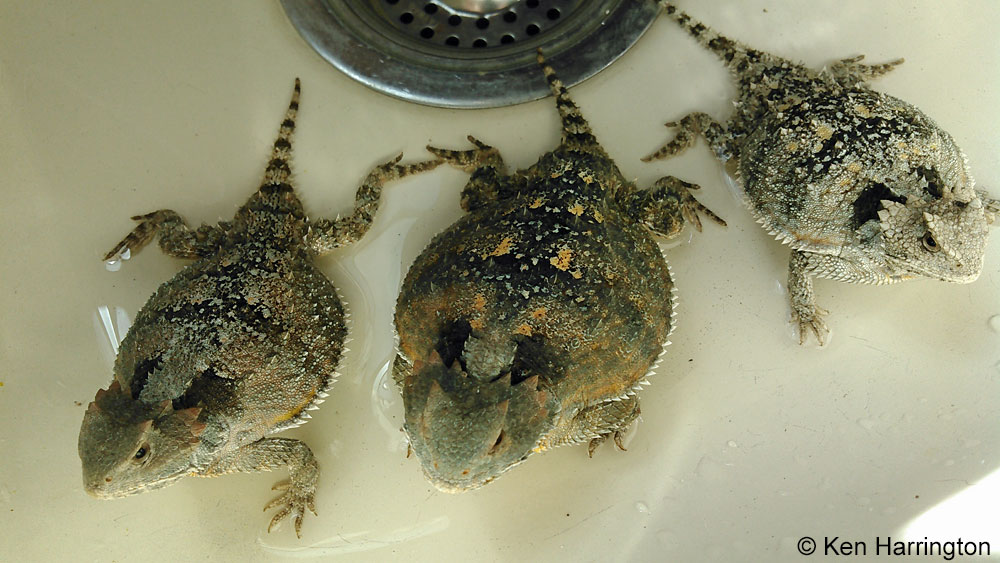 |
|
| © Ken Harrington It's rare for horned lizards to live near humans, but these adult short-horned lizards live in a yard in Arizona with plenty of the arge ants they need to feed on to survive. They allow handling and appear to appreciate being brought into the house occasionally for a drink of water. |
|
 |
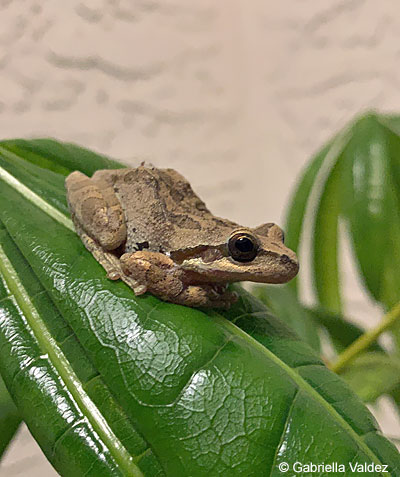 |
| Some snakes can climb up walls, especially when they can use an inside corner and a rough-texture to give them a grip. This San Diego Gophersnake was observed crawling up the stucco wall next to the front door on the outside of a house in Riverside County. © Gary Sopata |
Pacific Treefrogs (which may consist of three species) are common yard and garden visitors in rural areas. © Gabriella Valdez |
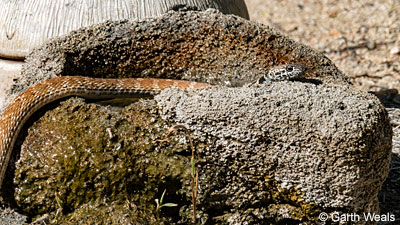 |
 |
| All kinds of wildlife can be found near water features in the desert, including snakes. This Red Racer is drinking water from a small fountain on some property in the Mojave Desert. © Garth Weals | |
 |
 |
| Adult Northern Pacific Rattlesnake coiled up under a drinking bowl for dogs in a park in Monterey County. This is a good reminder of the need to remain vigilant when you're in rattlesnake country, especially with your pets. © Mike German |
|
 |
 |
| This Southwestern Speckled Rattlesnake lives in a coastal San Diego County backyard and likes to bask on this stone fence where it can be difficult to see. © Sean Kelly |
|
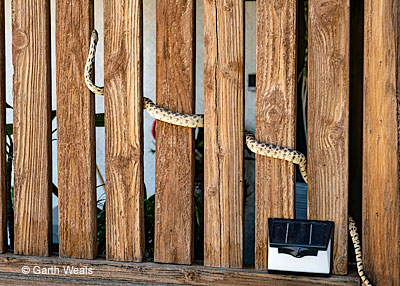 |
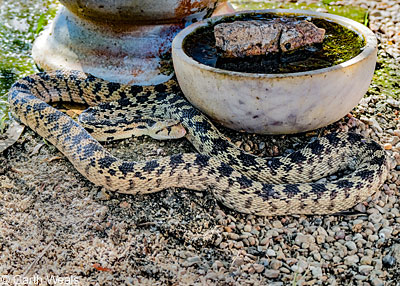 |
| This Great Basin Gophersnake is a resident of a Kern County desert property. It has been observed living under the garage, engaged in mating activity with two other snakes, and climbing the deck over a front door to get on the roof. © Garth Weals | |
 |
|
| This surprising visitor was found in a front yard in San Diego County. © Nick Jones |
|
Return to the Top
© 2000 -